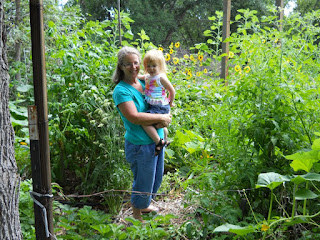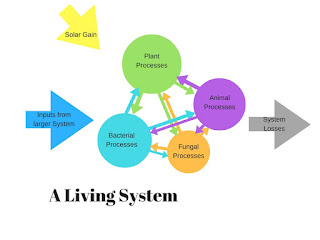Vertically Integrated in Chickens
A system of production that produces everything that it needs to operate has no cost. A system that uses everything it produces has no waste.
The Cook and the Gardener Partnership (CGP) is based on the concept of integrating processes and closing production loops. We can imagine the development of the chicken operation as a path through that process in which one part of the operation is related to all other parts of the operations.
In their economics class Pat and Chris learned the concept of vertical integration as a way to control the supply chain for their food truck sales. Vertically integrating the chicken portion requires that CGP can:
1 - produce fertile eggs to be incubated,
1 - produce fertile eggs to be incubated,
2 - raise the chicks for four months until the young roosters can be processed,
3 - raise the young hens an additional two months until they start laying eggs,
4 - collect the eggs,
5 - process the hens entering their third year,
6 - handle the meat from the young roosters and old hens,
7 - render the fat from the old hens,
8 - develop recipes and cooking skills to make meals of the eggs, meat and fat.
8 - develop recipes and cooking skills to make meals of the eggs, meat and fat.
We will require a space to host a flock that produces enough fertile eggs to meet the needs of our homeowners for chickens. This will require roosters. Roosters are banned in many residential areas so we will be looking at zoning regulations. Incubating a chicken egg takes 21 days and the incubator needs to be in a climate controlled area with few drafts.
CGP's homeowner partners will be buying the materials for a chicken coop. The laying hens will primarily be housed in small groups with each homeowner. Some homeowners might be willing to raise out the young birds up until the time the roosters start crowing . . . which is about four months and the roosters can be processed then . . . it will take another two months for the hens to start laying eggs.
It may be possible to build a mobile chicken processing facility and conduct the processing at the client's homes. If not, it will be necessary to have a space rented or owned by CGP for that purpose.
It may be possible to build a mobile chicken processing facility and conduct the processing at the client's homes. If not, it will be necessary to have a space rented or owned by CGP for that purpose.
Most of the eggs will be collected by the Homeowner partners as they do the daily maintenance for the chickens and greenhouse. The share for CGP can be picked up once per week when we do the weekly maintenance and harvesting. However, if CGP had a space to house laying hens we can also make an offer to individuals living in apartments or covenant controlled communities that do not allow chickens. How much we might charge for a share of the eggs and produce can be worked out as we go.
CGP will be developing recipes that use the chicken broth, chicken meat, chicken fat, chicken eggs and the produce that we grow in the green houses and gardens at the homes of our partners. We can always purchase additional foods such as flour or rice to create a balanced diet for customers and partners based on the foods we produce. The chicken part is just the example. We will want to produce what we want to cook and cook what we want to produce.
As with the landscaping services we provide for our homeowners, the food production at a property rented or owned by CGP would embedded in a habitat providing for a full range of plant, animal, fungal and bacterial processes.
As the partner base expands, the amount of produce expands, and the capacity to sell meals at the food truck expands, Chris and Pat will not be able to do all the work themselves. What can CGP offer potential working partners besides a regular supply of meals?
The ultimate goal of CGP is to provide food, shelter, learning, health, purpose and belonging to the working partners. That goal is funded through the cooperation of homeowner partners hiring us to do landscaping and partnering in the production of protein and fresh vegetables on the one side. And on the other side funding comes from the sale of nutrient dense meals at a reasonable price prepared using the things we produce.
If CGP were to rent or buy a property that allowed several or all of the eight tasks listed above, we might also be able to provide several or all of the things our working partners need to thrive and thereby attract the labor necessary to complete these tasks.
Chris and Pat decide to investigate the purchase of a large home on 5 to 10 acres zoned for agricultural uses. There are many details to be worked out. As a bottom line, CGP will need to earn enough to pay the mortgage payment in addition to the living expenses of the working partners.
How can we, as a community, help Chris and Pat achieve this milestone for CGP?
As with the landscaping services we provide for our homeowners, the food production at a property rented or owned by CGP would embedded in a habitat providing for a full range of plant, animal, fungal and bacterial processes.
As the partner base expands, the amount of produce expands, and the capacity to sell meals at the food truck expands, Chris and Pat will not be able to do all the work themselves. What can CGP offer potential working partners besides a regular supply of meals?
The ultimate goal of CGP is to provide food, shelter, learning, health, purpose and belonging to the working partners. That goal is funded through the cooperation of homeowner partners hiring us to do landscaping and partnering in the production of protein and fresh vegetables on the one side. And on the other side funding comes from the sale of nutrient dense meals at a reasonable price prepared using the things we produce.
If CGP were to rent or buy a property that allowed several or all of the eight tasks listed above, we might also be able to provide several or all of the things our working partners need to thrive and thereby attract the labor necessary to complete these tasks.
Chris and Pat decide to investigate the purchase of a large home on 5 to 10 acres zoned for agricultural uses. There are many details to be worked out. As a bottom line, CGP will need to earn enough to pay the mortgage payment in addition to the living expenses of the working partners.
How can we, as a community, help Chris and Pat achieve this milestone for CGP?







Comments
Post a Comment